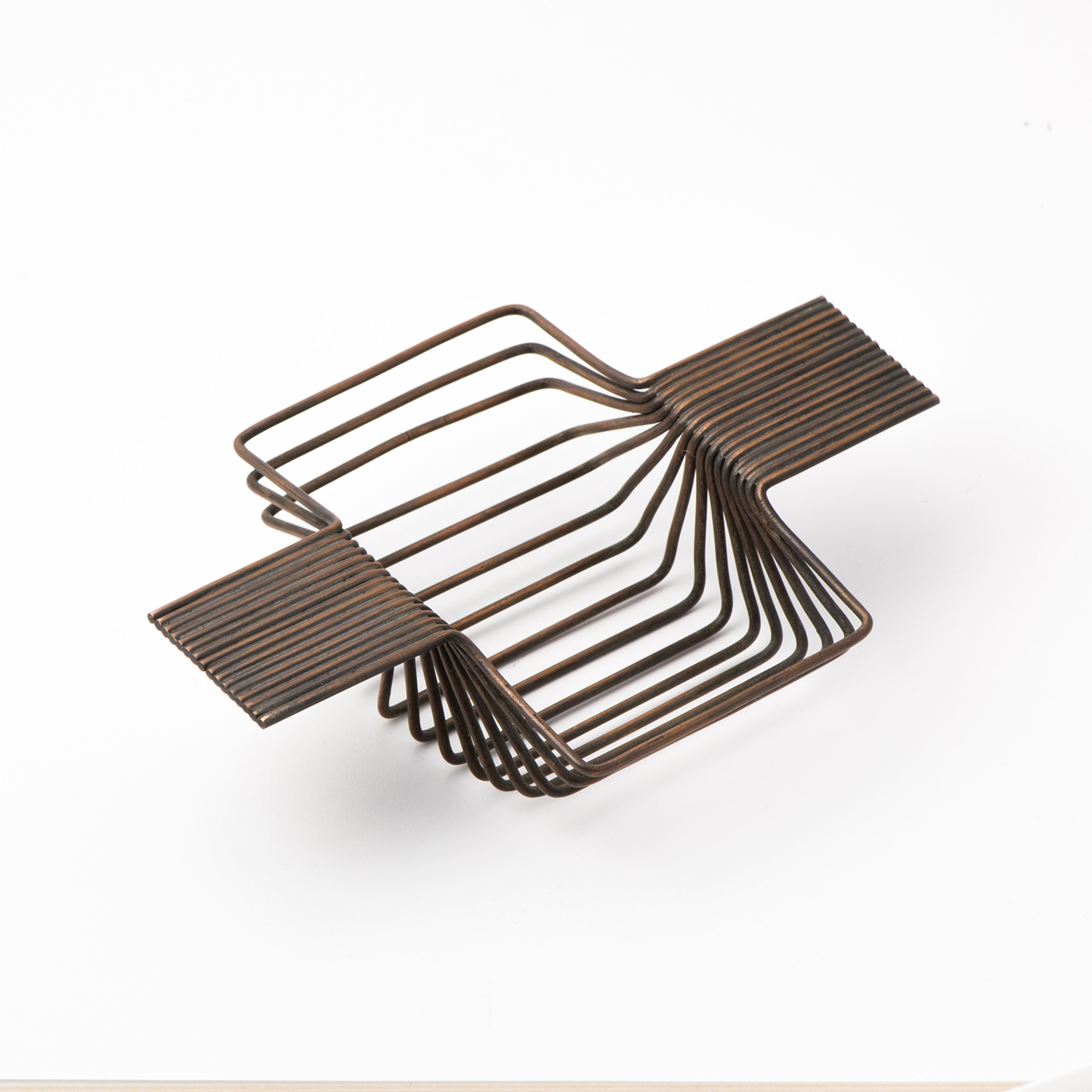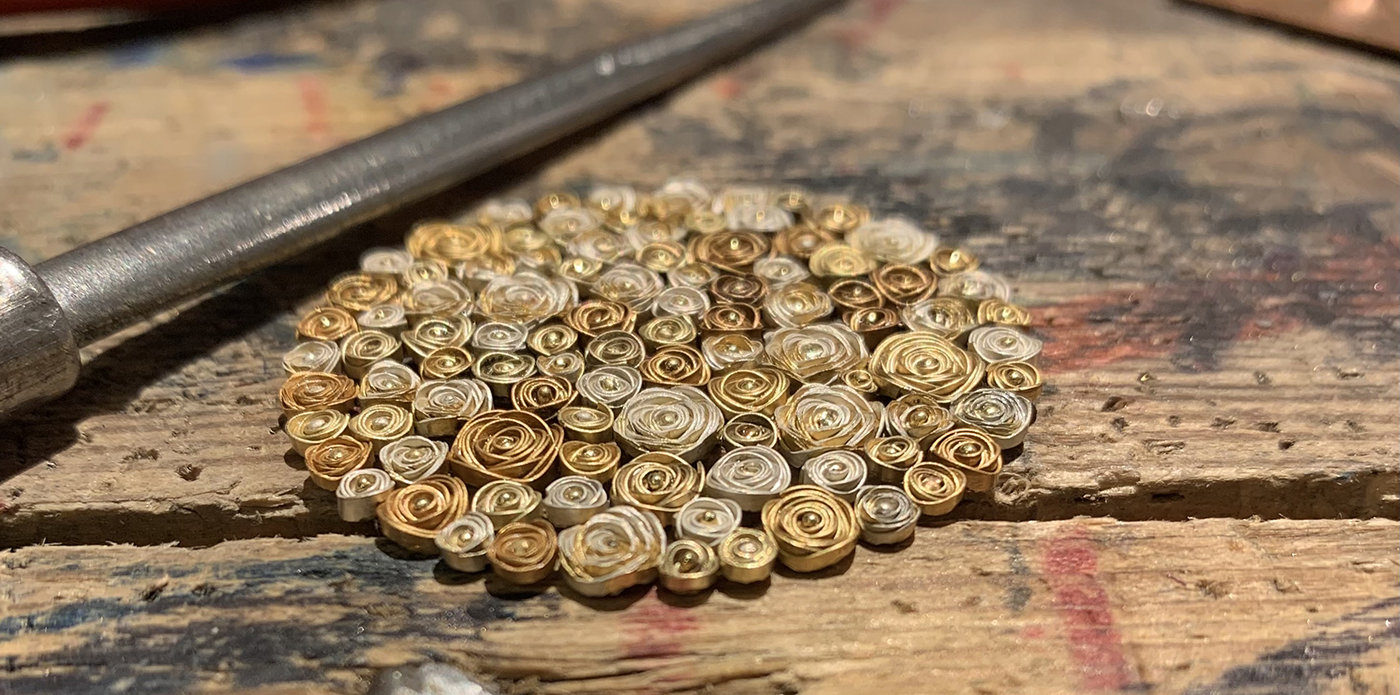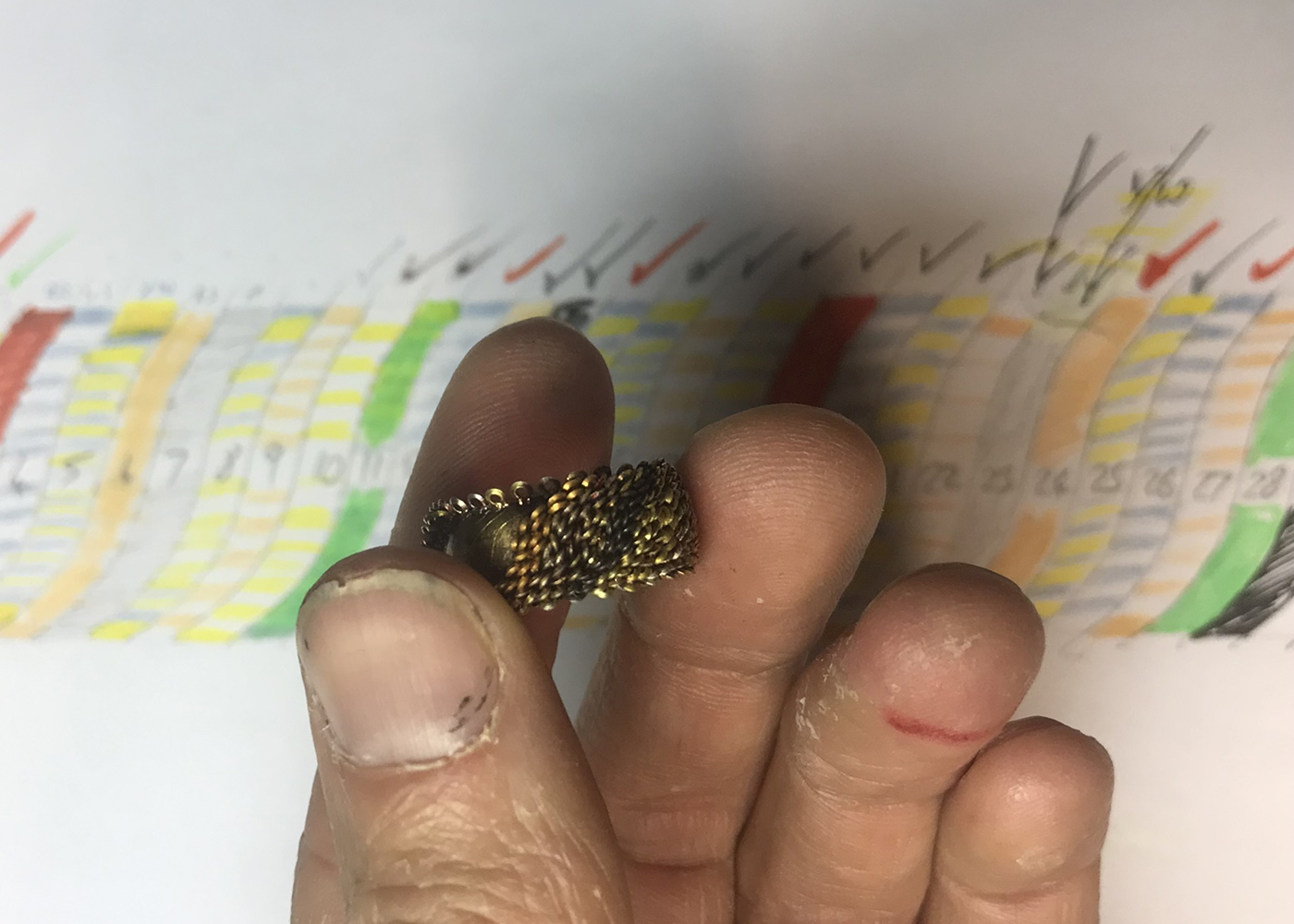The Gallery presents Linear Frequency, a solo exhibition from Andrew Lamb celebrating a career that spans 23 years. Andrew’s inspirations, influences and research interests have always been underpinned by traditional goldsmithing practices and methods that are thousands of years old.
We spoke to Andrew about his practice and the work in the exhibition. Read on to enjoy our Q&A…
This year marks your 23rd Anniversary as a jeweller. Is there a key moment in your career that stands out?
23 years… it’s admittedly hard to select just one key moment over that period. As my career has unfolded, some of the most pivotal experiences have been intertwined with my travels, which I consider myself fortunate to have undertaken.
Whilst there isn’t perhaps one moment in time, the opportunities I’ve had to explore different cultures and connect with people across the globe have undoubtedly shaped my work and in turn my artistic perspective. From my very first study trip to Munich in 1998, whilst a student at Edinburgh College of Art, to now taking my GSA students to Schmuck/Munich Jewellery Week, these travels reinforce the importance of keeping one’s finger on the pulse and continually broadening ones perspectives. Similarly, my involvement in teaching, participation in residencies, workshops and showcasing my work in various exhibitions have afforded me the pleasure of traveling to incredible destinations such as China, Japan, Denmark, Belgium, Bahrain, and South Africa. These experiences have not only further ignited my creativity but have also played a significant role in the evolution of my practice.
You work with extremely fine grades of wire. What drew you to this material and what is your favourite material to work with?
I have been referred to as being a “wireaholic” and that’s probably fairly accurate! My first experience of working in precious metal was during my time at Edinburgh College of Art (“ECA”). We were set a technical exercise to take scrap metal, melt it down, and then meticulously draw it down into wire to create a tiny form (see pic 1 below). Taking a solid ingot and turning it into something new was a process I found immensely fulfilling. It was transformative for me and my understanding of the possibilities that working in this way offered. A work experience placement with the brilliant silversmith Adrian Hope, who during the summer of 1998 let me loose in his workshop to make whatever I wanted, was another pivotal moment which drew me to wirework. I sketched a proposal to make this little copper wire dish (see pic 2 below). However, none of the wire required was available. Undeterred and undaunted, Adrian simply handed me a giant pair of cutting shears and a sizable sheet of very thick gauge metal for me to make my own! Thanks to Adrian, I quickly learned how to turn the very sharp slivers and twists into quantities of smooth round wire by carefully filing and pulling through the drawplates. On returning to ECA and sharing the piece with my tutor, the late Dorothy Hogg, she lifted it up and positioned it as if it was a brooch. From that point, I can trace my works initially becoming larger in scale and then more delicate (see pics 3 & 4). In later years on perusing my research sketchbooks, Dorothy remarked, “you must see the world as a series of lines”, which is true, and her words have helped guide the direction of my work.
Wire very quickly became the natural medium through which I could translate all my creative ideas into tangible objects, particularly jewellery. Wire allows me to create volume and visual movement. Its infinite possibilities keep driving and influencing my practice.




I’ve always enjoyed working in mixtures of precious materials incorporating multiple alloys and contrasting / subtle colours. In 2010 I was fortunate to receive funding from the Arts Foundation and travel to a week-long intensive masterclass with Giovanni Corvaja. Giovanni is undeniably a master in his field, and I consider myself extremely fortunate to have had the opportunity to spend time with him in Italy. His profound knowledge, theory, technical skills, and creative thinking process is unparalleled, and the time I spent undoubtedly enriched my own practice. What particularly stands out in my mind is the licence he gave me to work in an uninhibited way, ultimately giving me the confidence to further hone my technical and creative skills and expand my pallet of colours. It also reinforced my determination to innovate and explore the limitless possibilities goldsmithing and metalwork offer. What I love the most is that even today, 23 years on, I am still learning about different materials and the unexpected outcomes which can be produced when working in combination with gold.
Where do you start with your design process?
My design process stems from observing nature, textiles, optical principles, and the way we see and perceive world. I am happy to allow my work to evolve and I can trace a link between every single piece I have made back to test pieces or sketches from my time at ECA and the Royal College of Art. When invited to submit work for a themed exhibition, I thrive on challenging myself to meet the brief. For instance, one such exhibition titled Le Stanze Del Possible’(Hannah Gallery, Barcelona, curated by Nichka Marobin), I designed and created two pieces in response to Italo Calvino’s lecture about the virtue of quickness or rapidity. Italo thinks of quickness in a physical sense, but more importantly in relation to speed of thought. Much like Calvino, my ideas come to me as flashes of inspiration. That said, a creative spark will often take many weeks or even months to develop fully into the physical form. This is something Calvino recognised when he wrote, “it is natural to digress, to jump from one subject to another, to lose the thread a hundred times and find it again after a hundred more twists and turns”. In the same way he crafts his stories, by considering objects and their ability to tell a story, for me it is vital that visual flow, rhythm, movement, and spontaneity are translated into my finished pieces. From Calvino’s words, in particular my interpretation of the ancient legend and its protagonist which opens the lecture, I was inspired to design and make two rings* to illustrate the exploration of new forms. Each piece took on its own unique pattern following experiments with magnetic forces and metal filings. Mesmerising patterns, which seemed to have their own magic to them, quickly developed and then the making process began. This involved trying out, developing, and discarding ideas and the procrastination Calvino described, as my ideas were narrowed down into the finished pieces, was all too familiar.
*One of these pieces, the Lenticular Ring, 2019, features in this exhibition and the other was very recently purchased by the Victoria and Albert Museum, London.

Optical phenomena and visual illusions are subjects I’ve enjoyed exploring and continue to find inspiring. In designing and making, I aim to produce pieces which have an instant visual appeal, and which have the power to connect with viewer and wearer quickly yet continually puzzle and engage in its minute detail.
Is there an artist that you admire or inspires you?
In my final year as a student at Edinburgh College of Art, I came across an article by Clare Henry who described Bridget Riley, whom I have long admired, as an artist who ‘could always get her lines to billow and weave, spin and rotate, pull and tug, concertina and squeeze’ (Scotsman newspaper, 2000). Those words resonated with me because she was so successful at creating the illusion of three dimensions in 2D. As a maker, this reflected my hands-on approach to working with physical materials, applying ancient skills to pull, squeeze, weave and spin wire into three-dimensional forms, making each piece appear to come alive.



Can you describe a typical day in the studio?
Whilst I do spend most days in a studio environment, I spend it balanced between my own studio practice and my role as a lecturer at The Glasgow School of Art. This ensures that my daily experiences are ever-changing, which I love. There is no typical day, especially within the academic calendar. When it comes to time in my own workshop, this often leads me into the early hours of the morning, lost in the creative process, having to find a technical solution or experimenting with new concepts/materials. I work alongside amazing students and staff at GSA, it is an inspiring and stimulating environment for any creative, which furthers my enthusiasm for research and innovation.



Do you have a favourite piece that you’ve made over the years? If so, what makes it so special to you?
There is no easy answer. There are many pieces that I am proud of and pieces where I have challenged myself, and succeeded, in making something unique, advancing both artistic and technical skill. When those pieces go on to become a cherished possession, I take a huge amount of pleasure from that. Designing and making for those who are close to me is always a privilege.
I made a pair of earrings from my grandmother over 20 years ago and when she passed away, they were gifted to my wife who loves them just as much as my grandmother did. Seeing my work having a second lease of life is particularly special.




Watch Lamb’s Studio Insights film below…






